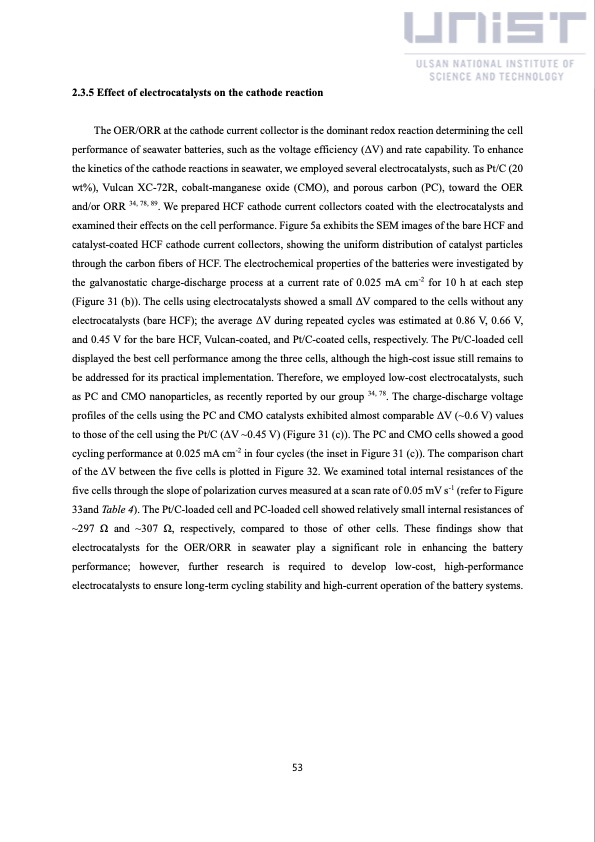
PDF Publication Title:
Text from PDF Page: 058
2.3.5 Effect of electrocatalysts on the cathode reaction The OER/ORR at the cathode current collector is the dominant redox reaction determining the cell performance of seawater batteries, such as the voltage efficiency (ΔV) and rate capability. To enhance the kinetics of the cathode reactions in seawater, we employed several electrocatalysts, such as Pt/C (20 wt%), Vulcan XC-72R, cobalt-manganese oxide (CMO), and porous carbon (PC), toward the OER and/or ORR 34, 78, 89. We prepared HCF cathode current collectors coated with the electrocatalysts and examined their effects on the cell performance. Figure 5a exhibits the SEM images of the bare HCF and catalyst-coated HCF cathode current collectors, showing the uniform distribution of catalyst particles through the carbon fibers of HCF. The electrochemical properties of the batteries were investigated by the galvanostatic charge-discharge process at a current rate of 0.025 mA cm-2 for 10 h at each step (Figure 31 (b)). The cells using electrocatalysts showed a small ΔV compared to the cells without any electrocatalysts (bare HCF); the average ΔV during repeated cycles was estimated at 0.86 V, 0.66 V, and 0.45 V for the bare HCF, Vulcan-coated, and Pt/C-coated cells, respectively. The Pt/C-loaded cell displayed the best cell performance among the three cells, although the high-cost issue still remains to be addressed for its practical implementation. Therefore, we employed low-cost electrocatalysts, such as PC and CMO nanoparticles, as recently reported by our group 34, 78. The charge-discharge voltage profiles of the cells using the PC and CMO catalysts exhibited almost comparable ΔV (~0.6 V) values to those of the cell using the Pt/C (ΔV ~0.45 V) (Figure 31 (c)). The PC and CMO cells showed a good cycling performance at 0.025 mA cm-2 in four cycles (the inset in Figure 31 (c)). The comparison chart of the ΔV between the five cells is plotted in Figure 32. We examined total internal resistances of the five cells through the slope of polarization curves measured at a scan rate of 0.05 mV s-1 (refer to Figure 33and Table 4). The Pt/C-loaded cell and PC-loaded cell showed relatively small internal resistances of ~297 Ω and ~307 Ω, respectively, compared to those of other cells. These findings show that electrocatalysts for the OER/ORR in seawater play a significant role in enhancing the battery performance; however, further research is required to develop low-cost, high-performance electrocatalysts to ensure long-term cycling stability and high-current operation of the battery systems. 53PDF Image | China solar seawater battery

PDF Search Title:
China solar seawater batteryOriginal File Name Searched:
solar-seawater.pdfDIY PDF Search: Google It | Yahoo | Bing
Product and Development Focus for Salgenx
Redox Flow Battery Technology: With the advent of the new USA tax credits for producing and selling batteries ($35/kW) we are focussing on a simple flow battery using shipping containers as the modular electrolyte storage units with tax credits up to $140,000 per system. Our main focus is on the salt battery. This battery can be used for both thermal and electrical storage applications. We call it the Cogeneration Battery or Cogen Battery. One project is converting salt (brine) based water conditioners to simultaneously produce power. In addition, there are many opportunities to extract Lithium from brine (salt lakes, groundwater, and producer water).Salt water or brine are huge sources for lithium. Most of the worlds lithium is acquired from a brine source. It's even in seawater in a low concentration. Brine is also a byproduct of huge powerplants, which can now use that as an electrolyte and a huge flow battery (which allows storage at the source).We welcome any business and equipment inquiries, as well as licensing our flow battery manufacturing.| CONTACT TEL: 608-238-6001 Email: greg@salgenx.com | RSS | AMP |